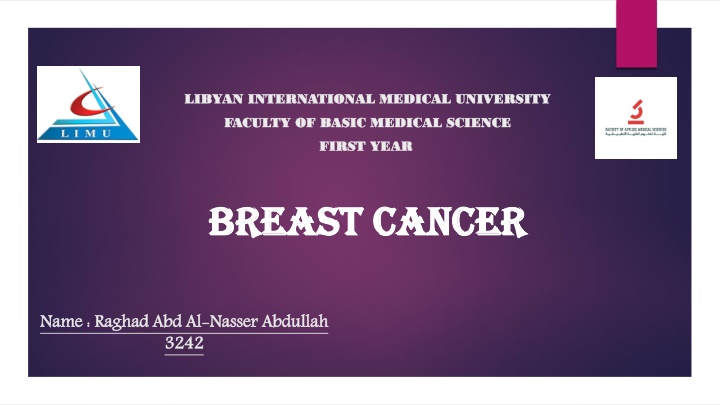
Breast Cancer Overview and Detection
Learn about breast cancer, its definition, signs, symptoms, risk factors, and treatment options. Understand the importance of early detection and the impact on women's health worldwide.
Uploaded on | 1 Views
Download Presentation

Please find below an Image/Link to download the presentation.
The content on the website is provided AS IS for your information and personal use only. It may not be sold, licensed, or shared on other websites without obtaining consent from the author. If you encounter any issues during the download, it is possible that the publisher has removed the file from their server.
You are allowed to download the files provided on this website for personal or commercial use, subject to the condition that they are used lawfully. All files are the property of their respective owners.
The content on the website is provided AS IS for your information and personal use only. It may not be sold, licensed, or shared on other websites without obtaining consent from the author.
E N D
Presentation Transcript
LIBYAN INTERNATIONAL MEDICAL UNIVERSITY LIBYAN INTERNATIONAL MEDICAL UNIVERSITY FACULTY OF BASIC MEDICAL FACULTY OF BASIC MEDICAL SCIENCE SCIENCE FIRST YEAR FIRST YEAR BREAST CANCER BREAST CANCER Name : Name : Raghad Raghad Abd Abd Al Al- -Nasser Abdullah 3242 Nasser Abdullah 3242
Objectives 1- DEFINE BREAST CANCER . 2- DISCUSS SIGNS SYMPTOMS OF BREAST CANCER . 3- RISK FACTOR BREAST CANCER . 4-TREATMENT OPTIONS FOR BREAST CANCER .
Introduction : The breast is made up of different tissue, ranging from very fatty tissue to very dense tissue. Breast cancer is the most common malignant tumor among women globally and causes the majority of cancer deaths in women.
definition breast cancer : Breast cancer is a disease in which cells in the breast grow out of control and There are different kinds of breast cancer ,The kind of breast cancer depends on which cells in the breast turn into cancer and Breast cancer can begin in different parts of the breast.
Breast is made up of three main parts :
Breast cancer signs & symptoms A persistent lump / atypical fullness / puckering / hard knot/thickening / dimpling / swelling in breast or in armpit or around collarbone area A change in skin color of breast / areola / nipple (reddening or darkening ) A change in size / shape of mature breast area
Breast cancer signs & symptoms A change in nipple (retracted / inverted - pulled in nipple ) or its position Discharge (liquid ) or blood from one or both nipples that occurs suddenly without squeezing Itch, constant pain , warmth or rash on - breast area / nipple / armpit
breast cancer TNM staging system TUMOR STAGE. 'STAGE' IS A MEASURE OF THE EXTENT OF THE TUMOR AT THE TIME OF DIAGNOSIS AND IS IMPORTANT FOR ALL BIOLOGICAL CANCERS 1) TUMOR SIZE (T): TUMOR SIZE CORRELATES WITH PROGNOSIS: LARGER TUMORS ARE ASSOCIATED WITH POORER SURVIVAL 2) LYMPH NODE STATUS (N): THE PRESENCE OR ABSENCE OF AXILLARY LYMPH NODE METASTASES IS A MAJOR PROGNOSTIC INDICATOR FOR PATIENTS WITH BREAST CANCER AND REQUIRES PATHOLOGICAL EVALUATION OF SURGICALLY REMOVED LYMPH NODES 3) DISTANT METASTASES (M): DISTANT METASTASES = POOR PROGNOSIS. BONES ARE THE MOST AFFECTED, AND IN SMALL PROPORTIONS OF PATIENTS METASTASES APPEAR IN THE LUNG, LIVER, CENTRAL NERVOUS SYSTEM, SKIN AND ADRENAL GLANDS.
Risk Factors for Breast Cancer Development Not Modifiable age (after 40 years of age) genetic BRCA germ line mutations, p53 mutation, amplification of the HER2 gene Modifiable Body mass index Diet, environmental and lifestyle factors Family history specifically First-degree relatives (mother, sister, or daughter) Chest radiation Alcohol smoking exogenous estrogen as hormone replacement therapy Lack of Exercise (increase the risk) Race/ethnicity Early menarche Late menopause, and null parity Breast density Age at first full-term delivery Lactation (reduce the risk)
Location: Location: The most common location for tumors within the breast is in the upper outer quadrant. About 4% of women diagnosed with breast cancer have bilateral primary tumors or sequential lesions in the same breast.
Treatment : There are many option for breast cancer. Breast cancer surgery. Radiation therapy. Chemotherapy. Immunotherapy. Hormone therapy. bone marrow transplantation.
CONCLUSION: Breast cancer is the most common type of tumor in women in most parts of the world. Although stabilized in Western countries, its incidence is increasing in other continents. Prevention of breast cancer is difficult because the causes are not well known.
References : 1- Cancer. World Health Organization. https://www.who.int/news-room/fact-sheets/detail/cancer Accessed Feb. 16, 2021. 2- Cancer stat facts: Cancer of any site. National Cancer Institute Surveillance, Epidemiology, and End Results Program. https://seer.cancer.gov/statfacts/html/all.html. Accessed Feb. 16, 2021. .1 3- Symptoms of cancer. National Cancer Institute. https://www.cancer.gov/about-cancer/diagnosis- staging/symptoms. Accessed Feb. 16, 2021. 4- Rock CL, et al. American Cancer Society guideline for diet and physical activity for cancer prevention. CA: A Cancer Journal for Clinicians. 2020;doi:doi.org/10.3322/caac.21591. .1
Thank Thank you you
